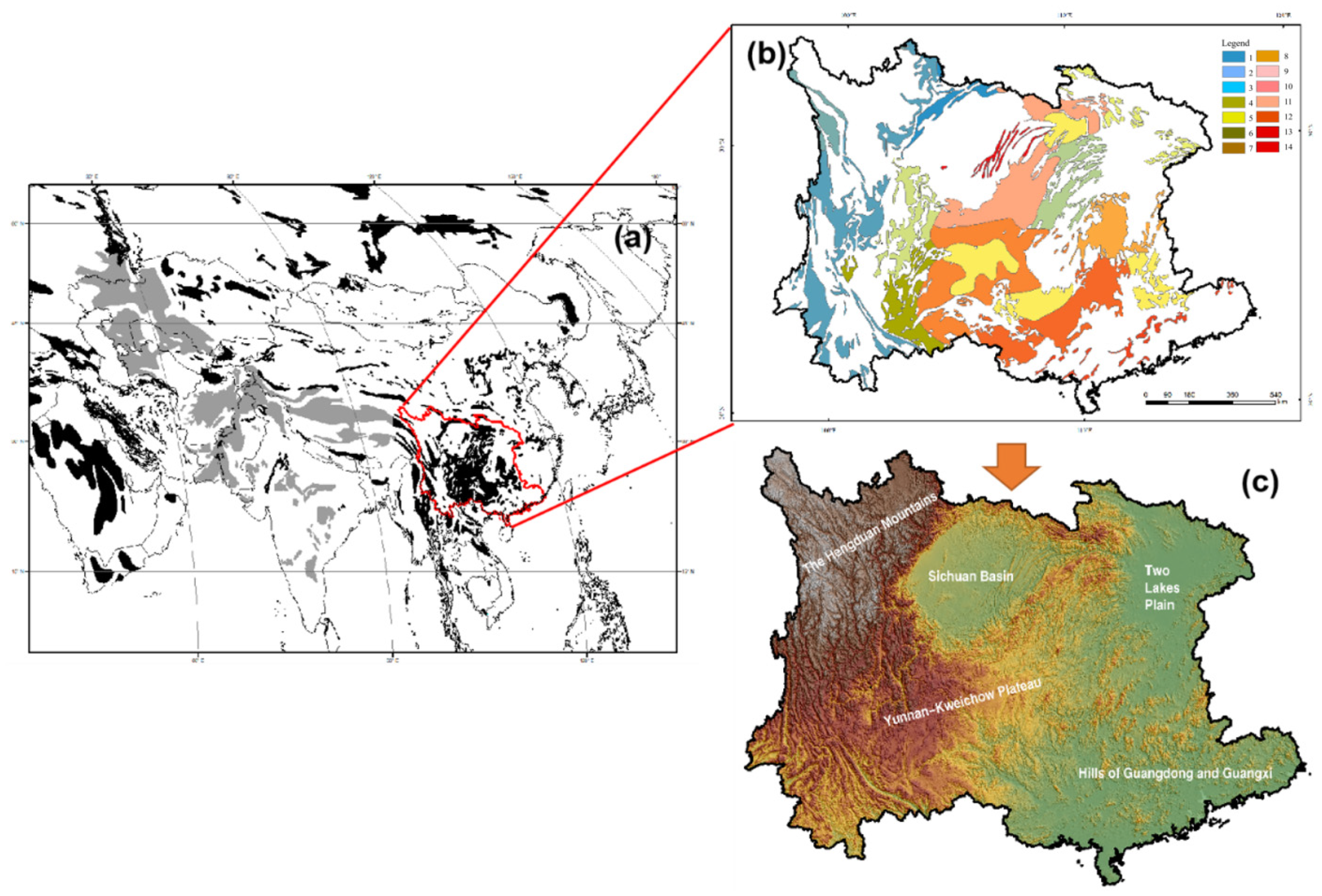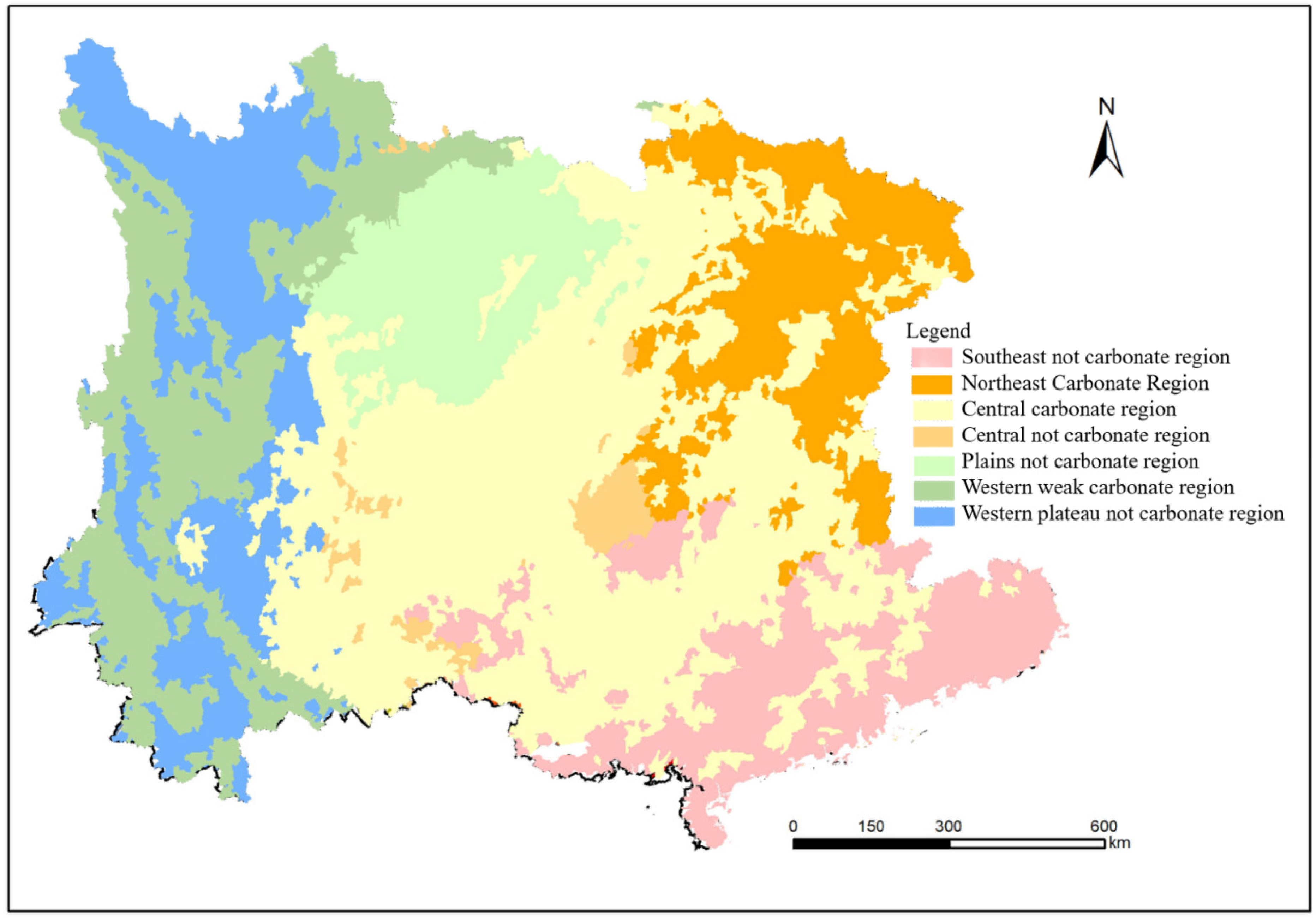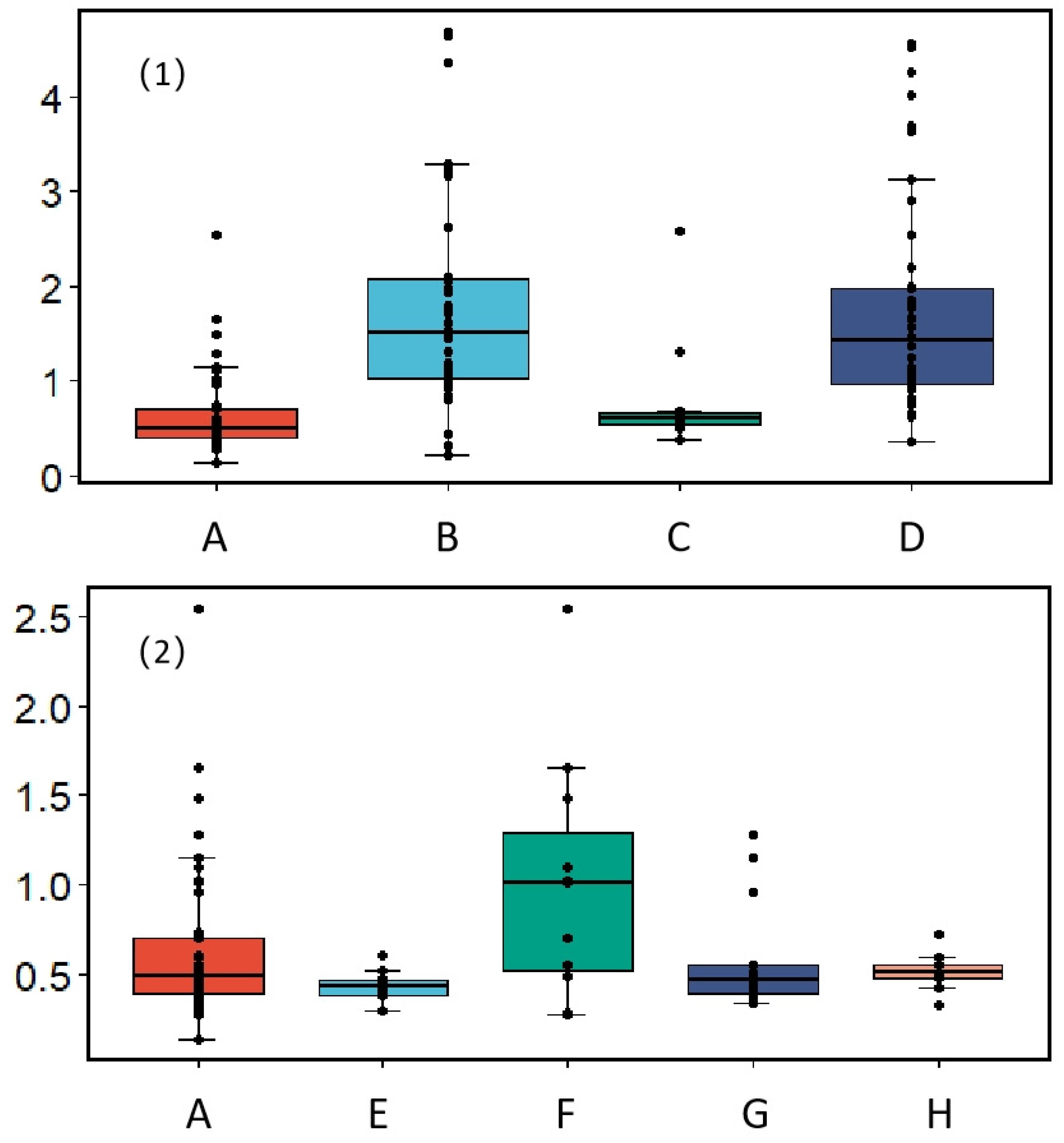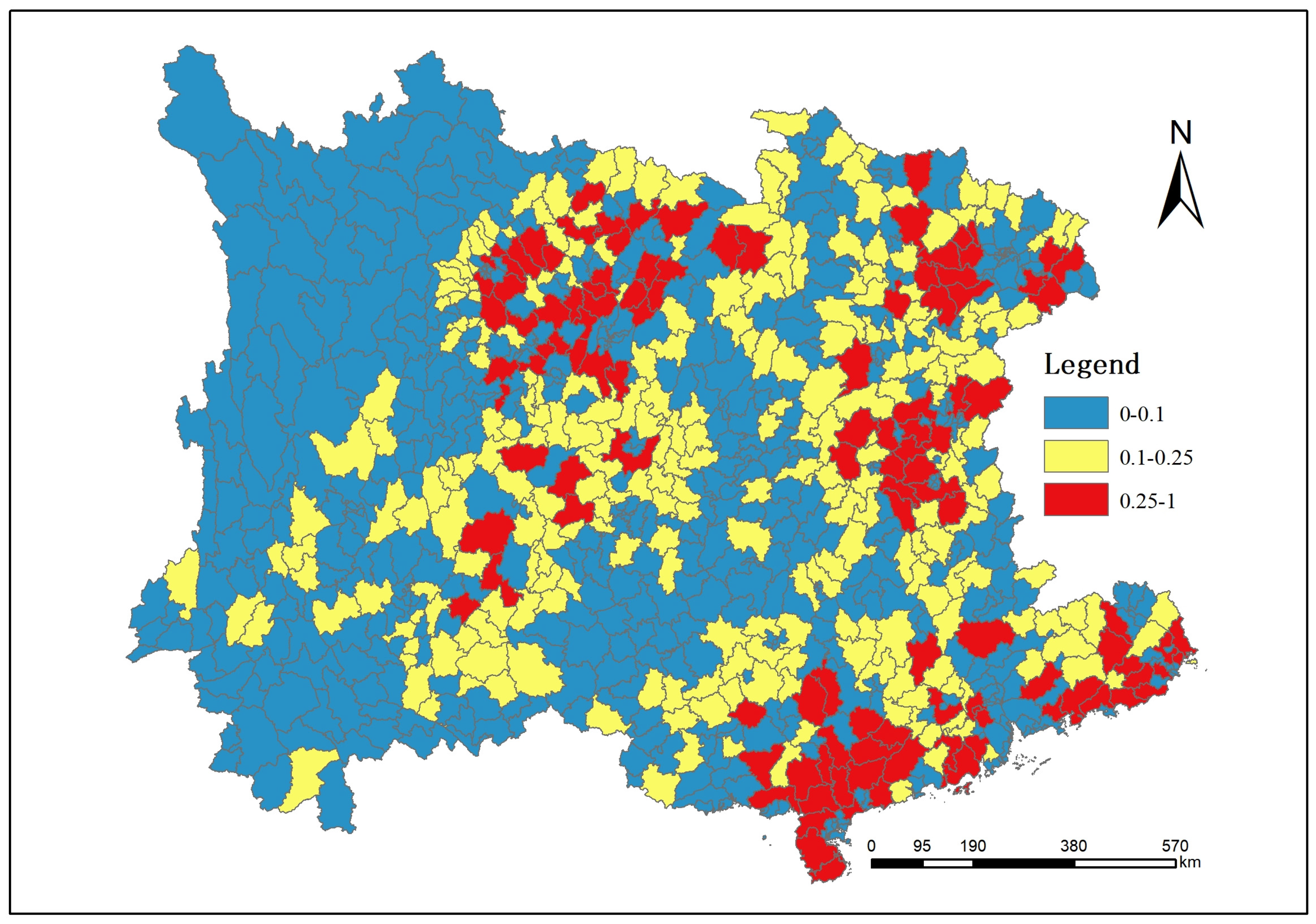Analysis of the Sources of Soil Heavy Metals in Geological High-Background Areas at a Large Spatial Scale
Abstract
1. Introduction
2. Materials and Methods
2.1. Description of the Study Area
2.2. Soil Sampling and Analysis
2.3. Analysis of Cumulative Risks
2.4. Quantification of the Intensity of Human Activities Related to Soil Heavy Metal Content
3. Results
3.1. Temporal Changes in Sampling Content
3.2. Statistical Analysis of Heavy Metal Concentrations Across Distinct Regions
3.3. Variation in Heavy Metal Vertical Content
4. Discussion
4.1. Sources and Impacts of Soil Heavy Metal
4.2. Correlation Analysis Between Carbonate Regions and Mineralization Belts
4.3. Limitations and Improvement
5. Conclusions
Author Contributions
Funding
Institutional Review Board Statement
Informed Consent Statement
Data Availability Statement
Conflicts of Interest
References
- Soja, C. Island-arc carbonates: Characterization and recognition in the ancient geologic record. Earth-Sci. Rev. 1996, 41, 31–65. [Google Scholar] [CrossRef]
- Yin, S.; Xie, Y.; Hou, Z.; Qu, Y.; Institute of Geology, Chinese Academy of Geological Sciences. A Review of Research Advances on Carbonatite. Acta Petrol. Sin. 2024, 40, 1003–1022. [Google Scholar] [CrossRef]
- Anenburg, M.; Broom-Fendley, S.; Chen, W. Formation of Rare Earth Deposits in Carbonatites. Elements 2021, 17, 327–332. [Google Scholar] [CrossRef]
- Yaxley, G.M.; Kjarsgaard, B.A.; Jaques, A.L. Evolution of Carbonatite Magmas in the Upper Mantle and Crust. Elements 2021, 17, 315–320. [Google Scholar] [CrossRef]
- Xia, X.; Ji, J.; Zhang, C.; Huang, C.; Lu, X.; Yang, Z. The degree of soil arsenic background enrichment by carbonate weathering is mainly controlled by climate in large spatial scale. Sci. Total Environ. 2024, 951, 175868. [Google Scholar] [CrossRef]
- Chen, M.; Li, X.; Cao, X.; Yang, W.; Wu, P.; Hao, H.; Fei, Z.; Gao, Y. Soil-forming accumulation of heavy metals in geological high background areas: Constraints of structure, lithology, and overlying soil geochemistry. J. Geochem. Explor. 2024, 263, 107518. [Google Scholar] [CrossRef]
- Yadav, S.K.; Attry, B.; Shukla, S.; Dutta, S.; Sharma, K.; Rajak, R.; Gupta, A.; Baruah, B.; Ranjan, R.K. Distribution, toxicity load and risk assessment of heavy metals in the groundwater of Dhemaji, Assam, India. Chemosphere 2024, 358, 141979. [Google Scholar] [CrossRef]
- Hu, Z.; Wu, Z.; Luo, W.; Liu, S.; Tu, C. Spatial distribution, risk assessment, and source apportionment of soil heavy metals in a karst county based on grid survey. Sci. Total Environ. 2024, 953, 176049. [Google Scholar] [CrossRef]
- Lin, K.; Yu, T.; Ji, W.; Li, B.; Wu, Z.; Liu, X.; Li, C.; Yang, Z. Carbonate rocks as natural buffers: Exploring their environmental impact on heavy metals in sulfide deposits. Environ. Pollut. 2023, 336, 122506. [Google Scholar] [CrossRef]
- Daldoul, G.; Souissi, R.; Souissi, F.; Jemmali, N.; Chakroun, H.K. Assessment and mobility of heavy metals in carbonated soils contaminated by old mine tailings in North Tunisia. J. Afr. Earth Sci. 2015, 110, 150–159. [Google Scholar] [CrossRef]
- Cui, J.-L.; Zhao, Y.-P.; Lu, Y.-J.; Chan, T.-S.; Zhang, L.-L.; Tsang, D.C.W.; Li, X.-D. Distribution and speciation of copper in rice (Oryza sativa L.) from mining-impacted paddy soil: Implications for copper uptake mechanisms. Environ. Int. 2019, 126, 717–726. [Google Scholar] [CrossRef] [PubMed]
- Crespo-Toledo, T.; Avelar-González, F.; Guerrero-Barrera, A.; Mitchell, K.; Yamamoto-Flores, L.; Flores-Amaro, O. Integrative assessment of heavy metal risks in mining polluted sediments and soils of Aguascalientes, Mexico. Case Stud. Chem. Environ. Eng. 2025, 11, 101130. [Google Scholar] [CrossRef]
- Hou, Y.; Ding, W.; Xie, T.; Chen, W. Prediction of soil heavy metal contents in urban residential areas and the strength of deep learning: A case study of Beijing. Sci. Total Environ. 2024, 950, 175133. [Google Scholar] [CrossRef]
- Rahmati, O.; Falah, F.; Dayal, K.S.; Deo, R.C.; Mohammadi, F.; Biggs, T.; Moghaddam, D.D.; Naghibi, S.A.; Bui, D.T. Machine learning approaches for spatial modeling of agricultural droughts in the south-east region of Queensland Australia. Sci. Total Environ. 2019, 699, 134230. [Google Scholar] [CrossRef] [PubMed]
- Negahban, S.; Mokarram, M.; Pourghasemi, H.R.; Zhang, H. Ecological risk potential assessment of heavy metal contaminated soils in Ophiolitic formations. Environ. Res. 2020, 192, 110305. [Google Scholar] [CrossRef]
- Zhang, L.; Qin, X.; Tang, J.; Liu, W.; Yang, H. Review of arsenic geochemical characteristics and its significance on arsenic pollution studies in karst groundwater, Southwest China. Appl. Geochem. 2017, 77, 80–88. [Google Scholar] [CrossRef]
- Chen, L.; Zhou, M.; Wang, J.; Zhang, Z.; Duan, C.; Wang, X.; Zhao, S.; Bai, X.; Li, Z.; Li, Z.; et al. A global meta-analysis of heavy metal(loid)s pollution in soils near copper mines: Evaluation of pollution level and probabilistic health risks. Sci. Total Environ. 2022, 835, 155441. [Google Scholar] [CrossRef]
- Peng, J.-Y.; Zhang, S.; Han, Y.; Bate, B.; Ke, H.; Chen, Y. Soil heavy metal pollution of industrial legacies in China and health risk assessment. Sci. Total Environ. 2021, 816, 151632. [Google Scholar] [CrossRef]
- Yang, Y.; Christakos, G.; Guo, M.; Xiao, L.; Huang, W. Space-time quantitative source apportionment of soil heavy metal concentration increments. Environ. Pollut. 2017, 223, 560–566. [Google Scholar] [CrossRef]
- Haney, R.L.; Haney, E.B.; Smith, D.R.; Harmel, R.D.; White, M.J. The soil health tool—Theory and initial broad-scale application. Appl. Soil Ecol. 2018, 125, 162–168. [Google Scholar] [CrossRef]
- Xia, X.; Yang, Z.; Yu, T.; Hou, Q.; Mutelo, A.M. Detecting changes of soil environmental parameters by statistics and GIS: A case from the lower Changjiang plain, China. J. Geochem. Explor. 2017, 181, 116–128. [Google Scholar] [CrossRef]
- Jia, Z.; Wang, J.; Zhou, X.; Zhou, Y.; Li, Y.; Li, B.; Zhou, S. Identification of the sources and influencing factors of potentially toxic elements accumulation in the soil from a typical karst region in Guangxi, Southwest China. Environ. Pollut. 2020, 256, 113505. [Google Scholar] [CrossRef] [PubMed]
- Jiang, Z.; Yang, S.; Luo, S. Source analysis and health risk assessment of heavy metals in agricultural land of multi-mineral mining and smelting area in the Karst region—A case study of Jichangpo Town, Southwest China. Heliyon 2023, 9, e17246. [Google Scholar] [CrossRef] [PubMed]
- He, Y.; Zhang, Q.; Wang, W.; Hua, J.; Li, H. The multi-media environmental behavior of heavy metals around tailings under the influence of precipitation. Ecotoxicol. Environ. Saf. 2023, 266, 115541. [Google Scholar] [CrossRef]
- Xia, X.; Yang, Z.; Yu, T.; Zhang, C.; Hou, Q. Predicting spatial and temporal variation of Cd concentration in rice grains in the Lower Changjiang Plain during 2004–2014 based on soil geochemical survey data with GIS. J. Geochem. Explor. 2019, 200, 276–283. [Google Scholar] [CrossRef]
- Qu, S.; Wu, W.; Nel, W.; Ji, J. The behavior of metals/metalloids during natural weathering: A systematic study of the mono-lithological watersheds in the upper Pearl River Basin, China. Sci. Total Environ. 2019, 708, 134572. [Google Scholar] [CrossRef]
- Qin, W.; Han, D.; Song, X.; Liu, S. Sources and migration of heavy metals in a karst water system under the threats of an abandoned Pb-Zn mine, Southwest China. Environ. Pollut. 2021, 277, 116774. [Google Scholar] [CrossRef]
- Mendes, P.R.; Salavati, S.; Linares, O.C.; Gonçalves, M.M.; Zampieri, M.F.; de Sousa Ferreira, V.H.; Castro, M.; de Oliveira Werneck, R.; Moura, R.; Morais, E.; et al. Rock-type classification: A (critical) machine-learning perspective. Comput. Geosci. 2024, 193, 105730. [Google Scholar]
- Wu, Y.; Li, X.; Yu, L.; Wang, T.; Wang, J.; Liu, T. Review of soil heavy metal pollution in China: Spatial distribution, primary sources, and remediation alternatives. Resour. Conserv. Recycl. 2022, 181, 106261. [Google Scholar] [CrossRef]
- Shi, J.; Zhao, D.; Ren, F.; Huang, L. Spatiotemporal variation of soil heavy metals in China: The pollution status and risk assessment. Sci. Total Environ. 2023, 871, 161768. [Google Scholar] [CrossRef]
- Qin, G.; Niu, Z.; Yu, J.; Li, Z.; Ma, J.; Xiang, P. Soil heavy metal pollution and food safety in China: Effects, sources and removing technology. Chemosphere 2020, 267, 129205. [Google Scholar] [CrossRef] [PubMed]
- Shi, T.; He, L.; Wang, R.; Li, Z.; Hu, Z.; Wu, G. Digital mapping of heavy metals in urban soils: A review and research challenges. Catena 2023, 228, 107183. [Google Scholar] [CrossRef]
- Kowalska, J.; Mazurek, R.; Gąsiorek, M.; Setlak, M.; Zaleski, T.; Waroszewski, J. Soil pollution indices conditioned by medieval metallurgical activity—A case study from Krakow (Poland). Environ. Pollut. 2016, 218, 1023–1036. [Google Scholar] [CrossRef]
- Xu, L.; Dai, H.; Skuza, L.; Wei, S. Comprehensive exploration of heavy metal contamination and risk assessment at two common smelter sites. Chemosphere 2021, 285, 131350. [Google Scholar] [CrossRef]
- Cao, Y.; Zhang, J.; Zhang, Z.; Tang, H.; Liu, L.; Liu, X.; Ma, R.; Zhang, M.; Zhang, X. The difference in ecological environmental quality impact factors between human activity zone and non-human activity zone in arid regions: A case study of the northern slope of the Tianshan Mountains. Ecol. Indic. 2025, 171, 113226. [Google Scholar] [CrossRef]
- Dong, J.; Chi, Y.; Zou, D.; Fu, C.; Huang, Q.; Ni, M. Energy–environment–economy assessment of waste management systems from a life cycle perspective: Model development and case study. Appl. Energy 2014, 114, 400–408. [Google Scholar] [CrossRef]
- Ejaz, U.; Khan, S.M.; Shah, S.F.A.; Khalid, N.; Jehangir, S.; Rizvi, Z.F.; Svenning, J.-C. Advanced Integrative Analytics for Data-Driven Risk Assessment of Ecological and Human Health Risks from Heavy Metal Contaminations in Soil. J. Hazard. Mater. Adv. 2025, 17, 100596. [Google Scholar]
- Li, C.; Zhang, C.; Yu, T.; Liu, X.; Yang, Y.; Hou, Q.; Yang, Z.; Ma, X.; Wang, L. Use of artificial neural network to evaluate cadmium contamination in farmland soils in a karst area with naturally high background values. Environ. Pollut. 2022, 304, 119234. [Google Scholar] [CrossRef]
- Wen, Y.; Li, W.; Yang, Z.; Zhang, Q.; Ji, J. Enrichment and source identification of Cd and other heavy metals in soils with high geochemical background in the karst region, Southwestern China. Chemosphere 2019, 245, 125620. [Google Scholar] [CrossRef]
- Yao, C.; Yang, Y.; Li, C.; Shen, Z.; Li, J.; Mei, N.; Luo, C.; Wang, Y.; Zhang, C.; Wang, D. Heavy metal pollution in agricultural soils from surrounding industries with low emissions: Assessing contamination levels and sources. Sci. Total Environ. 2024, 917, 170610. [Google Scholar] [CrossRef]
- Jiang, S.; Su, H.; Xiong, Y.; Liu, T.; Zhu, K.; Zhang, L. Spatial-Temporal Distribution, Geological Characteristics and Ore-Formation Controlling Factors of Major Types of Rare Metal Mineral Deposits in China. Acta Geol. Sin.—Engl. Ed. 2020, 94, 1757–1773. [Google Scholar] [CrossRef]
- Chen, X.; Han, L.; Ding, W.; Xu, S.; Tong, Y.; Zhang, Y.; Li, B.; Zhou, Q.; Wang, Y. Phanerozoic Tectonic Evolution, Metallogenesis and Formation of Mineral Systems in China. Acta Geol. Sin.—Engl. Ed. 2024, 98, 819–842. [Google Scholar] [CrossRef]
- Hu, J.; Yang, X.; Chi, H.; Liu, X.; Lu, N.; Liu, Y.; Yang, S.; Wen, X. Transport, pollution, and health risk of heavy metals in “soil-medicinal and edible plant-human” system: A case study of farmland around the Beiya mining area in Yunnan, China. Microchem. J. 2024, 207, 111958. [Google Scholar] [CrossRef]







| Element | Mean (mg/kg) | Standard Deviation | Variation Coefficient (%) | Skewness | Kurtosis | Exceeding Rate (%) |
|---|---|---|---|---|---|---|
| Cd | 1.16 | 3.03 | 262 | 7.02 | 59.81 | 53.9 |
| Hg | 0.22 | 0.45 | 209 | 8.48 | 84.7 | 0.65 |
| As | 26.48 | 37.34 | 141 | 3.16 | 11.3 | 19.48 |
| Pb | 58.51 | 66.41 | 114 | 3.01 | 9.34 | 14.29 |
| Cr | 97.13 | 63.68 | 66 | 2.05 | 4.76 | 10.39 |
| Nemerow | 2.75 | 6.99 | 255 | 7.46 | 66.8 | 54.55 |
Disclaimer/Publisher’s Note: The statements, opinions and data contained in all publications are solely those of the individual author(s) and contributor(s) and not of MDPI and/or the editor(s). MDPI and/or the editor(s) disclaim responsibility for any injury to people or property resulting from any ideas, methods, instructions or products referred to in the content. |
© 2025 by the authors. Licensee MDPI, Basel, Switzerland. This article is an open access article distributed under the terms and conditions of the Creative Commons Attribution (CC BY) license (https://creativecommons.org/licenses/by/4.0/).
Share and Cite
Qin, Z.; Li, L.; Wu, X. Analysis of the Sources of Soil Heavy Metals in Geological High-Background Areas at a Large Spatial Scale. Sustainability 2025, 17, 3518. https://doi.org/10.3390/su17083518
Qin Z, Li L, Wu X. Analysis of the Sources of Soil Heavy Metals in Geological High-Background Areas at a Large Spatial Scale. Sustainability. 2025; 17(8):3518. https://doi.org/10.3390/su17083518
Chicago/Turabian StyleQin, Zhiheng, Li Li, and Xiuqin Wu. 2025. "Analysis of the Sources of Soil Heavy Metals in Geological High-Background Areas at a Large Spatial Scale" Sustainability 17, no. 8: 3518. https://doi.org/10.3390/su17083518
APA StyleQin, Z., Li, L., & Wu, X. (2025). Analysis of the Sources of Soil Heavy Metals in Geological High-Background Areas at a Large Spatial Scale. Sustainability, 17(8), 3518. https://doi.org/10.3390/su17083518






